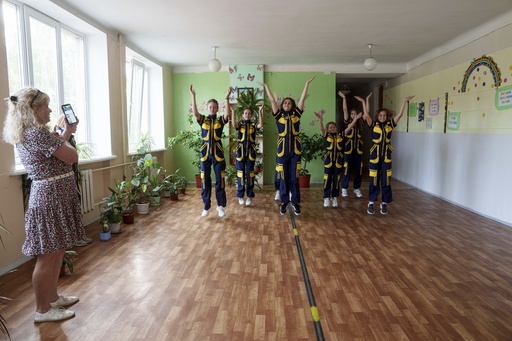
In this city, the perils come in many forms, from everyday bombs and artillery to the looming shadow of the nearby Zaporizhzhia Nuclear Power Plant (NPP), which has been under Russian control since the outset of the invasion. Previously the largest electricity producer in Europe, the plant has been a source of anxiety for families, especially as both sides trade blame for the attacks on the facility.
For many families in Zaporizhzhia, the combined threat of aerial assaults and radiation creates a unique kind of terror. Most of the younger residents have not set foot in a traditional classroom since the pandemic’s onset four years ago, a situation that has only worsened since hostilities began in February 2022. The local educational system has adapted with online classes, prioritizing safety as explosions and missile strikes continue to disrupt daily life.
In an effort to secure their children’s education, the city is embarking on a bold initiative to construct underground schools capable of withstanding bombings and potential radiation fallout, catering to approximately 12,000 students. Officials are optimistic about following this with plans for underground hospitals to further safeguard public health.
Kateryna Ryzhko, a mother of two, expressed the urgency felt by parents in the city. She noted that the original school building, dating back to the Soviet era, is well-maintained but currently deserted as students remain at home. The underground school is nearing completion, and she wouldn’t think twice about sending her kids back to school. For many, including herself, online learning has proven inadequate, resulting in social disconnect among classmates and a longing for face-to-face interaction. “Even classmates don’t recognize each other,” she lamented, emphasizing that the underground option represents the safest means for education amid the turmoil.
When Russia launched its full-scale invasion in early 2022, the 300,000 inhabitants of Zaporizhzhia suddenly found themselves on the front lines. Unlike larger Ukrainian cities, Zaporizhzhia lacks extensive bomb shelters, making evacuation during an attack extremely challenging. Though many fled, the homes and Soviet-era buildings quickly filled with displaced families from nearby areas that fell under Russian control.
By September 2022, the local schools that were meant to reopen for in-person learning were empty, their windows boarded up for safety against blasts. Meanwhile, the NPP went into cold shutdown, having become a focal point of concern highlighted by the International Atomic Energy Agency (IAEA). Despite the reactor being offline, the plant still requires a stable electrical supply from Ukrainian-controlled areas that are regularly targeted by Russian fire. Loss of power could lead to catastrophic consequences if backup systems fail.
Recent observations during visits to the Ukrainian-controlled areas near the nuclear plant revealed the magnitude of the danger; Russian strikes on power infrastructure were terrifyingly close to daily occurrences. President Volodymyr Zelenskyy has expressed apprehension that Russian forces might be deliberately targeting nuclear installations, recalling the disastrous fallout from the 1986 Chornobyl incident. Although the design of the Zaporizhzhia facility is considered safer than Chornobyl, the threat still persists.
Experts agree that the substantial investments in protective infrastructure may seem extreme elsewhere, but in the context of Ukraine’s current realities, they make sense. Security measures are increasingly seen as essential, with emergencies prompting international support in the form of iodine pills to help mitigate potential radiation exposure.
As the conflict rages on, fears of nuclear disasters loom large. Zelenskyy has raised alarms about possible attacks on other nuclear sites, stressing that a catastrophic event could pose a grave danger beyond Ukrainian borders.
Despite the daunting financial burden of building these underground facilities—like Gymnasium No. 71, which costs around 112 million hryvnias ($2.7 million)—officials have deemed it a necessary priority. Donor contributions have played a vital role, and regional leaders are equating educational security with military funding. “If we lose the new generation of our Ukrainians, for whom are we fighting?” declared Ivan Fedorov, the head of the Zaporizhzhia region.
Students, such as 15-year-old Daria Oncheva, eagerly anticipate the chance to return to their education in safer conditions. Meanwhile, other schools, including School No. 88, are already near completion, incorporating advanced materials and designs to absorb potential hazards from blasts and radiation. Experts assert that being below ground significantly increases survival rates during nuclear emergencies, though some activists argue against merely building defenses instead of entirely eliminating the threat of nuclear weapons.
Lyudmila Zlatova, the principal at School No. 88, longs for a future that minimizes risks from conflict, actively working to establish an educational environment capable of withstanding current threats. For families still in the city, safety is paramount; they hope that with these new developments, they can draw back those who have temporarily relocated elsewhere in Ukraine or in Europe.
Meanwhile, other schools have adapted their existing structures to create safer environments, such as Gymnasium No. 6, which converted its basement into classrooms. Although conditions remain tense, schools like this are finding solutions amidst chaos and preparing students to continue their education amid the array of uncertainties.
As the academic year begins, the air raid sirens remind everyone of the reality of living in Zaporizhzhia today, but they stand ready for the challenges ahead.
